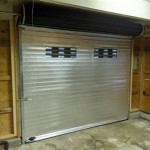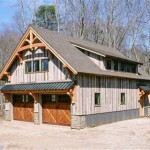Replacing Spring On Garage Door: A Comprehensive Guide
Garage door springs are critical components responsible for counterbalancing the weight of the door, allowing it to open and close smoothly. Over time, these springs can wear out due to constant use and environmental factors, eventually leading to breakage. A broken garage door spring can render the door inoperable and potentially dangerous. Replacing a garage door spring is a task often best left to professionals due to the high tension involved, but with the proper knowledge, tools, and safety precautions, some homeowners may choose to undertake this project themselves. This article provides a detailed guide to understanding the process of replacing garage door springs.
Understanding Garage Door Springs
There are two primary types of garage door springs: torsion springs and extension springs. Torsion springs are mounted above the garage door opening and operate by twisting and storing energy. Extension springs are located along the side tracks of the garage door and operate by stretching and contracting. Identifying the type of spring your garage door utilizes is the first step in the replacement process, as the procedures and tools required differ significantly. Incorrect spring selection can lead to improper door operation and potential safety hazards.
Torsion springs are generally considered more durable and safer than extension springs, as they are less likely to snap and fly off when broken. They are also capable of handling heavier doors. Extension springs, on the other hand, are typically found in older or lighter garage door systems and are generally easier to replace, although still requiring caution.
The lifespan of a garage door spring is measured in cycles, where one cycle represents one opening and closing of the door. The number of cycles a spring is rated for depends on its quality and construction. It is crucial to select replacement springs with a cycle rating that meets or exceeds the anticipated usage of the garage door. Factors like the frequency of use and the weight of the door directly impact the longevity of the springs.
Garage door springs are under immense tension, even when the door is closed. This high tension is what allows them to counterbalance the weight of the door. Releasing this tension safely is the most critical aspect of the replacement process. Failure to do so can result in serious injury or property damage. Therefore, understanding the mechanics of how these springs function is paramount before attempting any repair.
Essential Tools and Safety Equipment
Before attempting to replace a garage door spring, it is essential to gather the necessary tools and safety equipment. Working with high-tension springs presents significant risks, and having the right tools and protective gear is crucial for minimizing the potential for injury.
The following tools are typically required for torsion spring replacement: winding bars (usually ½ inch diameter and 18-24 inches long), adjustable wrench, socket wrench set, safety glasses, work gloves, a ladder, and possibly a vise grip. For extension spring replacement, you will generally need safety cables, pliers, a wrench, safety glasses, and work gloves.
Safety glasses are essential to protect the eyes from flying debris in case a spring breaks unexpectedly. Work gloves provide a better grip and protect the hands from sharp edges on the springs and hardware. Using the correct size winding bars is crucial for safely releasing and winding the torsion springs. Incorrectly sized bars can slip and cause the spring to unwind violently.
Safety cables are absolutely crucial for extension springs. These cables run through the center of the springs and act as a safety measure in case a spring breaks loose. They prevent the spring from flying across the garage, which can cause serious injury. Before beginning any work, ensure that these safety cables are properly installed and in good condition.
A sturdy ladder is necessary to reach the torsion springs, which are typically located above the garage door opening. Ensure the ladder is stable and placed on a level surface. It is also recommended to have a helper assist with holding the ladder and providing additional support during the process. Prior to starting any work, completely disconnect the garage door opener from its power source to prevent accidental activation during the repair.
Step-by-Step Guide to Replacing Torsion Springs
Replacing torsion springs requires meticulous attention to detail and strict adherence to safety protocols. The following steps provide a detailed guide to the process:
1.
Secure the Door:
Begin by using clamps or locking pliers to secure the garage door to the tracks. This prevents the door from moving while you are working on the springs. Place the clamps just above the rollers on each side of the door.2.
Loosen Set Screws:
Locate the set screws on the torsion spring shaft on both sides of the center bearing plate. Use a socket wrench to loosen these screws. This will allow you to slide the old spring off the shaft.3.
Insert Winding Bars:
Insert one winding bar into the winding cone of the broken spring. Use the bar to hold the spring in place while you loosen the set screws on the winding cone. Slowly and carefully unwind the spring by alternately loosening the set screws and inserting the second winding bar into the next hole in the winding cone. Repeat this process until all the tension is released from the spring.4.
Remove the Old Spring:
Once all the tension is released, slide the winding cone off the spring. Then, loosen the set screws on the stationary cone and slide the entire spring assembly off the torsion shaft. Discard the old spring safely and properly.5.
Install the New Spring:
Slide the new spring onto the torsion shaft, ensuring it is the correct spring for your garage door. Slide the stationary cone onto the spring and tighten the set screws. Then, slide the winding cone onto the spring.6.
Wind the New Spring:
Insert one winding bar into the winding cone and begin winding the spring. The number of turns required depends on the height of your garage door. A general rule is one turn for every foot of door height, plus an additional quarter turn. Use the second winding bar to hold the spring in place as you wind. Be precise and methodical in this process.7.
Tighten Set Screws:
Once the spring is fully wound, tighten the set screws on the winding cone. Remove the winding bars and carefully tighten the set screws on the stationary cone.8.
Lubricate the Spring:
Apply garage door lubricant to the spring to ensure smooth operation. This will also help extend the lifespan of the spring.9.
Test the Door:
Remove the clamps from the garage door tracks and test the door. It should open and close smoothly without any resistance. If the door does not operate correctly, re-evaluate the spring tension and adjust as necessary.Step-by-Step Guide to Replacing Extension Springs
Replacing extension springs, while seemingly simpler, still requires a cautious approach. Here's a detailed guide:
1.
Secure the Door:
Manually close the garage door and clamp it in place on both sides of the tracks with locking pliers or C-clamps. This will prevent the door from unexpectedly opening while you are working.2.
Secure the Safety Cables:
Ensure the safety cables are properly installed and running through the center of the existing springs. If not, install them now. These cables are critical for preventing the spring from flying across the garage if it breaks.3.
Detach the Old Spring:
Disconnect the extension spring from the track brackets or the S-hooks that connect it to the door and the track. Use pliers or a wrench to carefully detach these connections. Be prepared for some tension to be released when disconnecting the spring.4.
Remove the Old Spring:
Slide the old spring off the safety cable. If the cable is frayed or damaged, replace it as well. Discard the old spring safely.5.
Install the New Spring:
Slide the new spring onto the safety cable. Ensure the spring is the correct size and weight capacity for your garage door.6.
Connect the New Spring:
Connect the new spring to the track brackets and the S-hooks. Ensure all connections are secure and properly aligned.7.
Adjust the Tension:
Adjust the tension on the springs as needed. This can be done by moving the position of the S-hooks on the track or by adjusting the spring length using the track brackets. The goal is to have the door balanced so that it stays in place when opened halfway.8.
Test the Door:
Remove the clamps from the garage door tracks and test the door. It should open and close smoothly without any resistance. If the door is unbalanced, readjust the spring tension until it operates correctly.Important Safety Precautions
Replacing garage door springs involves working with high-tension components, and therefore, safety should be the top priority. Ignoring safety precautions can result in severe injuries or property damage.
Always wear safety glasses to protect your eyes from flying debris. Wear work gloves to protect your hands and improve your grip. Never attempt to replace a garage door spring without understanding the risks involved and having the necessary tools and equipment.
If you are unsure about any step in the process, it is best to consult a qualified garage door technician. Professionals have the expertise and equipment to safely and efficiently replace garage door springs. Do not attempt to replace a garage door spring if you are uncomfortable or lack the necessary skills.
Never stand directly in front of or behind a garage door spring while working on it. Always stand to the side to avoid being struck by a spring if it breaks or comes loose. Disconnect the garage door opener from its power source before beginning any work to prevent accidental activation of the door.
Regularly inspect your garage door springs for signs of wear and tear, such as rust, cracks, or stretching. Replacing worn springs before they break can prevent more serious problems and ensure the safe operation of your garage door.

Simple Tutorial On Garage Door Spring Replacement

Garage Door Spring Replacement When And Why It S Necessary Moore Overhead

Diy Garage Door Torsion Spring Replacement A1 Experts

How To Replace A Garage Door Spring

Garage Door Torsion Spring Replacement How To Youtube

Garage Door Spring Replacement A 2024 Guide

Spring Repair And Replacement Habprogaragedoors Com

How To Replace Garage Door Spring

Garage Door Spring Replacement Repair Guide Clopay

Garage Door Spring Replacement Needs Tools And Training








